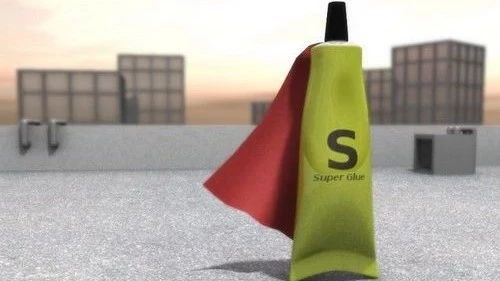
Let's make 502 the universal glue festival.
before you know it, 520 seems to be an informal holiday. But every time I see someone mention 520, I always think of only one thing-502.
since I was a child, the 502 glue in my mind is a very magical existence, it seems to be able to glue anything in an instant, and the bonding force is so strong that there is no room for remorse. It is often called "superglue", "universal glue", the English name is superglue, the name reveals a kind of superhuman feeling.
the key ingredient in strong glue is cyanoacrylate (Cyanoacrylate), in which the component is ethyl α-cyanoacrylate. Some glue dries simply by solvent volatilization, while superglue changes chemically: it only needs to come into contact with a little water from the outside world (even water vapor in the air is enough), and they will polymerize to form strong polymers that quickly bond objects together.
the following is a schematic diagram of the reaction process, which is taken from CompoundInterest:
the nature of quickly gluing things may now seem very convenient, but when cyanoacrylate was first born, this left researchers bald: because what they wanted to develop was not glue.
the birth of superglue can be said to be an accident. During World War II, researcher Harry Coover wanted to develop a transparent plastic suitable for gun sight, and cyanoacrylate was one of his candidate materials. In his research, he found that it simply clung to whatever it touched, and he couldn't make what he wanted, so he gave up.
at that time, Coover did not realize the value of such substances as adhesives. Then in the 1950s, he was involved in another research project to develop a fire-resistant polymer suitable for aircraft canopies. This time, one of Coover's students synthesized ethyl cyanoacrylate and tried to measure the refractive index of the sample. As a result, the two prisms are firmly glued together by these substances. This time, they finally realized: it's a pity to catch something sticky and not to make glue. In 1958, adhesives containing cyanoacrylate entered the market.
Cyanoacrylate polymerizes in the presence of water, which means that its adhesion properties are not compromised on slightly moist surfaces-such as human tissue. In medical treatment, there are also adhesives containing cyanoacrylate, which can sometimes be used instead of sutures to anastomose the wound easily and quickly. It should be noted that long-chain cyanoacrylate is used in medical glue, and its chemical composition is different from 502, which cannot be used to stick wounds. )
of course, fast and strong adhesives are not always the best, and the most important thing is to design and choose them according to different needs. Sometimes weak stickiness is more convenient, such as post-it notes, which can be pasted repeatedly and easily torn off without leaving a trace.
in addition to sticking things, superglue has a special use: displaying fingerprints. For more information, you can learn about → motion picture appreciation: displaying fingerprints with strong glue
finally, the next question that is often asked: how to remove 502glue? Generally speaking, the most effective thing against solidified 502 glue is acetone. Pure acetone is not common in daily life, but many nail polish removers contain acetone and can be used.
reference to this article:
http://www.chm.bris.ac.uk/motm/superglue/superglueh.htm
Elegant and magnificent, our magenta bridesmaid dresses will make you look regal. Our online shopping makes your shopping experience easy and happy.
http://www.compoundchem.com/2015/10/15/superglue/